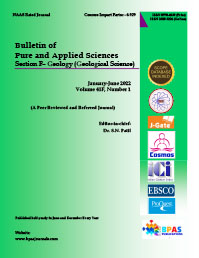Groundwater Contamination through Major Ions and Their Probable Effects on Human Health in Aligarh, Uttar Pradesh, India
DOI:
https://doi.org/10.48165/bpas.2023.42F.2.8Keywords:
Groundwater, Irrigation, Electrical Conductivity, Ionic ConcentrationAbstract
All living things require water to maintain their life and carry out their metabolic functions. The quality of groundwater degrades as a result of unethical human involvement in natural systems and excessive groundwater resource use. Since groundwater is routinely used both directly for drinking and for other purposes, it is necessary to examine its quality. The hydrochemistry of the groundwater in Aligarh, Uttar Pradesh, India, was examined to assess its appropriateness for irrigation and drinking, as well as any potential effects on locals' health. Twenty-three groundwater samples were taken from submersible and hand pumps, and their physical and chemical characteristics, including electrical conductivity, pH, total dissolved solids (TDS), Na+, K+, Ca+2, Mg+2, Cl+2, HCO3-, CO32-,and SO42-, were measured. The groundwater's ionic concentrations fluctuate geographically and momentarily, and the water is alkaline. Higher values of particular characteristics at specified places signify groundwater pollution, rendering it unfit for use in various applications.
Downloads
References
Franks F, (2000). Water: A Matrix of Life, 2nd Edition, RSC Paperback, UK, pp 225.
Mohrir A. Ramteke D.S., Moghe C.A., Wate S.R. and Sarin R. (2009). Surface and Groundwater Quality Assessment in Binaregion, IJEP, 9, 22.
Kožíšek, František (2003). Health significance of drinking water calcium and magnesium. National Institute of Public Health 29, 9285-9286.
APHA (1998) Standard methods for the examination of water and wastewater, 20th edn. American Public Health Association, Washington DC, 220 p
Morin-Crini, Nadia, et al. (2022). Worldwide cases of water pollution by emerging contaminants: a review. Environmental Chemistry Letters. 1-28.
Bunnell J. E., Finkelman R. B., Centeno J. A. and Selinu O. (2007). Medical Geology: A globally Emerging Discipline. Geologica Acta, 5(3), 273-281.
McMahon FG et al. (1982). Upper gastrointestinal lesions after potassium chloride supplements: a controlled clinical trial. Lancet, 2, 1059–1061.
McMahon FG et al. (1984). Effect of potassium chloride supplements on upper gastrointestinal mucosa. Clinical Pharmacology and Therapeutics, 35, 852–
Ramesh, R., Subramanian, V. and Ramanathan, A.L. (2001). Point and Non point sources of Groundwater Pollution: Case Studies along the East Coast of India. Proceedings of the International Workshop on Ecohydrology, Capital Publishing Company, New Delhi, India, pp107.
Hill (1940). Geochemical patterns in the Coachella valley, california, Transand Laboratory Staff, USDA Handbook. 60 : 160.
Piper (1994). Graphical procedure in the geochemical interpretation of water analysis.
WHO (World Health Organization) (2004). Guidelines for drinking water quality, vol 1, 3rd edn. WHO, Geneva, p 515.
Downloads
Published
Issue
Section
License

This work is licensed under a Creative Commons Attribution-NonCommercial-NoDerivatives 4.0 International License.



